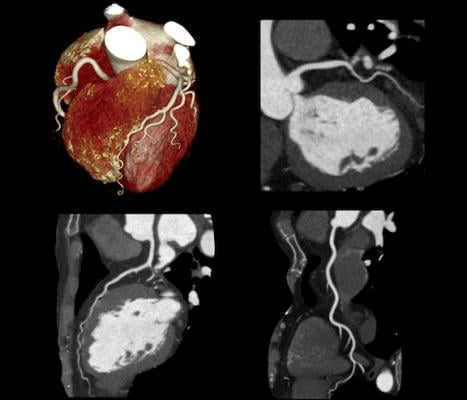
Coronary CT angiography images courtesy of Canon Medical Systems.
January 18, 2020) — The Society of Cardiovascular Computed Tomography (SCCT), in collaboration with the North American Society of Cardiovascular Imaging (NASCI), recently released a new expert consensus document on coronary CT imaging of atherosclerotic plaque.
This document, which is published in the Journal of Cardiovascular Computed Tomography and co-published in NASCI’s International Journal of Cardiovascular Imaging,[1] provides a comprehensive review of the available evidence on imaging of coronary atherosclerosis and standardized definitions for high-risk plaque (HRP) features and distilled evidence on the effectiveness of risk stratification into usable practice points.
According to Leslee Shaw, Ph.D., MSCCT, chair and lead author of the expert consensus: “Coronary computed tomographic angiography (CCTA) provides a wealth of clinically meaningful information. This consensus will serve as a guide given that previously, there has been no uniform agreement on how to identify and quantify the presence or absence of nonobstructive atherosclerosis and high-risk plaque features as precursors for incident coronary events or their use in evidence-based clinical decision-making.”
Growing evidence over the past decade has accumulated regarding the prognostic significance of nonobstructive and obstructive atherosclerotic plaque and its importance for estimating patient risk and guiding preventive care. Rigorous documentation of atherosclerosis on CCTA provides a vital opportunity to make recommendations for preventive care and to initiate and guide an effective care strategy for at-risk patients.
Shaw goes on to say “This consensus acknowledges both the advantages and limitations of current methods used to assess atherosclerotic plaque in an effort to identify future research that may be needed in this area as further advancements are made and the field rapidly evolves.”
This statement focuses on the following principal issues that will influence how we think about imaging coronary atherosclerotic plaque:
• CT Imaging of Atherosclerotic Plaque: Risk prediction in stable and unstable chest pain syndromes
• Evidence Gaps in Coronary Atherosclerotic Plaque Imaging and Future Research Needs
• CT Plaque Imaging to Direct Risk-Reducing Preventive or Disease-Modifying Therapies: Observational evidence on CCTA-guided preventive strategies
• Minimum Data Elements for Structured Reporting For Coronary Atherosclerotic Plaque
Consensus Summary and Recommendations
Read the full expert consensus document here.
For more information: www.SCCT.org
Reference:


 August 09, 2024
August 09, 2024 








